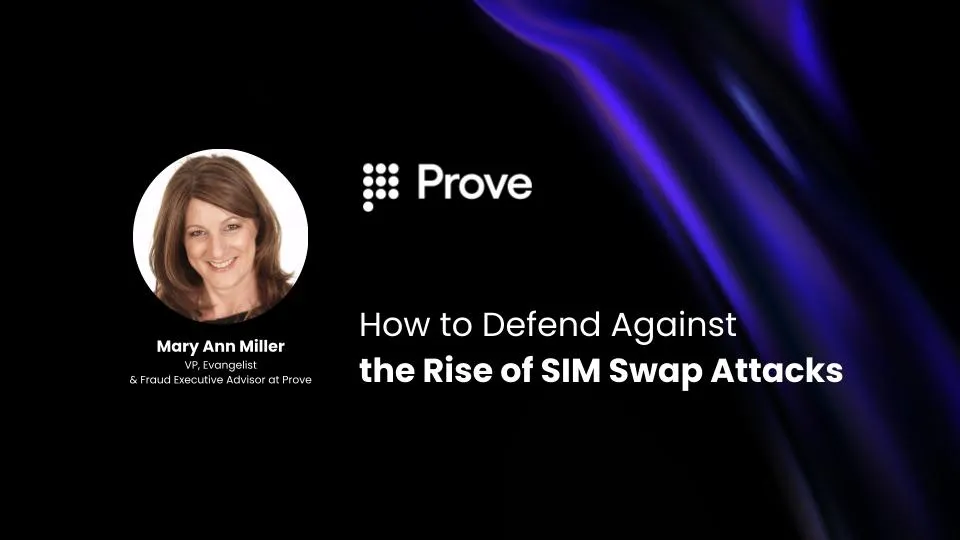How to Defend Against the Rise of SIM Swap Attacks


SIM swapping has become one of the most used fraud schemes, and has been on the rise over the past few years. The Federal Trade Commission (FTC) received reports of a significant increase in SIM swap attacks in 2023, and Experian's 2024 scam forecast identified SIM swapping as one of the top threats, emphasizing the need for heightened awareness and preventive measures.
This alarming trend exploits vulnerabilities in two-factor authentication, as bad actors intercept one-time passcodes to gain unauthorized access to accounts. Adding to the concern is the rise of insider threats within telecommunications companies, where employees are being bribed with substantial sums, sometimes up to $3,000 as seen on Telegram channels, to facilitate SIM swaps for malicious purposes.
Unmasking SIM Swapping: How Scammers Hijack Your Phone Number
SIM swapping happens when a scammer manipulates your mobile carrier into transferring your phone number to a SIM card they control. This is often done by deceiving customer service representatives into believing they are speaking to you. Once the scammer gains control of your number, they can intercept SMS one-time passwords used for two-factor authentication, giving them access to your bank account and other sensitive services. This allows them to initiate fraudulent activities such as transferring funds, linking external accounts, ordering cards, or depositing fake checks.
Let’s look at this in a bit more detail.
To pull off a SIM swap, scammers first need to gather your personal information – things like your name, birthday, and address. They might get this through sneaky tactics like tricking you into giving it up (social engineering), sending you fake emails or texts (phishing), or exploiting data breaches.
Armed with your details, the scammer contacts your mobile carrier pretending to be you. They'll make up a story about losing your phone or SIM card and needing to transfer your number to a new one. Sometimes, they'll even bribe a carrier employee to help them.
If the carrier falls for their lies, they'll switch your number to the scammer's SIM card. Suddenly, they're in control – intercepting your calls, texts, and any verification codes sent to your phone. This opens the door to all sorts of trouble, from draining your bank account to taking over your online accounts.
SIM swapping is a dangerous scam that can wreak havoc on your digital life, so it's crucial to stay vigilant and protect your personal information.
Why Are SIM Swap Attacks On the Rise?
SIM swapping has become more prevalent due to the ease with which login credentials can be obtained through data breaches. While many organizations implemented SMS-based two-factor authentication to counter this risk, cybercriminals are constantly finding ways to bypass these security measures due to the potential for significant financial gains. There's a growing trend of insider threats within telecommunications companies, where employees are being recruited and paid by bad actors to carry out SIM swaps. Social media platforms like Telegram are used to lure these insiders with promises of substantial rewards for each successful swap.
SIM swapping has grown into a significant threat due to a combination of factors:
- Data Breaches and Credential Availability: The frequency and magnitude of data breaches have made it easier for criminals to obtain personal information like names, addresses, and phone numbers, which are essential for initiating SIM swaps. Dark web marketplaces often sell this data, making it readily accessible to malicious actors.
- Reliance on SMS-Based Two-Factor Authentication (2FA): Many organizations still rely on SMS-based 2FA, which is vulnerable to interception through SIM swapping. When a scammer gains control of a victim's phone number, they also gain access to verification codes sent via SMS, effectively bypassing this security layer.
- Insider Threats within Telecom Companies: A disturbing trend involves employees of telecommunications companies being compromised or bribed to facilitate SIM swaps. These insiders have access to customer data and can override security measures, making them valuable accomplices for attackers.
- Lucrative Payouts for Criminals: Successful SIM swap attacks can lead to significant financial gains for criminals. Access to bank accounts, cryptocurrency wallets, and other sensitive information can be monetized quickly, incentivizing attackers to target this vulnerability.
- Limited Awareness and Prevention Measures: While awareness of SIM swapping is growing, many individuals and organizations are still unaware of the risks and how to protect themselves. This lack of awareness makes them easy targets for sophisticated social engineering tactics used by scammers.
- The Rise of Cryptocurrency: The increasing popularity of cryptocurrencies has made SIM swap attacks more attractive to criminals. Crypto wallets are often linked to phone numbers, making them vulnerable to SIM swapping. Additionally, the decentralized nature of cryptocurrency can make it difficult to recover stolen funds.
- Evolving Tactics of Cybercriminals: As security measures improve, criminals adapt their techniques to stay ahead. They are constantly developing new social engineering tactics, phishing schemes, and ways to exploit vulnerabilities in mobile networks and authentication systems.
Combatting SIM Swap Attacks
To combat the rising threat of SIM swap attacks, industry leaders are recommending the integration of specialized SIM swap detection technology, such as Prove, into various online processes. Tools like real-time SIM swap detection solutions, such as Prove’s Trust Score ® or other trust indicators. These tools analyze behavioral patterns and phone intelligence signals to assess the risk of fraud and verify the identity of the user behind a transaction. By implementing trust scores, companies gain valuable insight into whether a SIM swap has recently occurred on an account. Armed with this information, they can promptly take action to safeguard the user's account, such as implementing additional security measures or temporarily restricting certain activities until the user's identity is confirmed.
This technology is particularly crucial for any action that involves step-up authentication through SMS, including:
- Account opening: During the initial setup of a new account, SIM swap detection can verify the legitimacy of the phone number provided.
- Login with a new device: When accessing an account from an unfamiliar device, this technology can add an extra layer of security by confirming the user's identity through their SIM card.
- Password reset: Password reset requests often involve SMS verification codes, making them susceptible to SIM swap attacks. Detection technology can flag suspicious activity and prevent unauthorized resets.
- Adding a new payee: In banking apps, adding a new payee typically requires SMS confirmation. SIM swap detection can ensure that the request is coming from the legitimate account holder.
- Payment initiation: When initiating payments or transactions, SIM swap detection can verify the user's identity before authorizing the action, preventing unauthorized access to funds.
In the event that SIM swap activity is detected, financial institutions or other service providers can take immediate action to protect the user's account. This might involve temporarily suspending transactions, requiring additional verification, or contacting the customer directly to confirm their identity.
By incorporating SIM swap detection technology, businesses can significantly enhance their security measures and safeguard their customers from the devastating consequences of this increasingly prevalent form of fraud.
To learn more about using the Prove platform to support your SIM swap defense strategy, talk with the Prove team and let’s get started.

Keep reading
 Read the article: Prove Launches Global Identity Graph to Redefine Digital Trust for 90% of Digital Consumers
Read the article: Prove Launches Global Identity Graph to Redefine Digital Trust for 90% of Digital ConsumersProve has launched its Global Identity Graph, a foundational platform that connects verified human identities to their digital tokens, redefining digital trust and enabling instant, frictionless, and secure engagement for over 90% of digital consumers worldwide.
 Read the article: Prove Partners with Hard Rock Bet to Deliver Elite Onboarding and Enhance Player Experience
Read the article: Prove Partners with Hard Rock Bet to Deliver Elite Onboarding and Enhance Player ExperienceProve and Hard Rock Bet partner to deliver elite player onboarding by using Prove Pre-Fill® to instantly verify identities, streamline signup, and enhance security in online gaming.
 Read the article: Prove and Backbase Partner to Enable Faster and Safer Onboarding for Financial Institutions
Read the article: Prove and Backbase Partner to Enable Faster and Safer Onboarding for Financial InstitutionsThe Prove Pre-Fill solution integrates with Backbase’s AI-powered Banking Platform to reduce fraud, streamline data entry, and improve digital account opening experiences.












